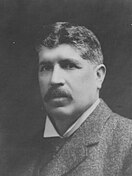| |||||||||||||||||||||||||||||||||||||||||||||
All 65 seats in the Victorian Legislative Assembly 33 seats needed for a majority | |||||||||||||||||||||||||||||||||||||||||||||
|---|---|---|---|---|---|---|---|---|---|---|---|---|---|---|---|---|---|---|---|---|---|---|---|---|---|---|---|---|---|---|---|---|---|---|---|---|---|---|---|---|---|---|---|---|---|
| |||||||||||||||||||||||||||||||||||||||||||||
| |||||||||||||||||||||||||||||||||||||||||||||
The 1908 Victorian state election was held in the Australian state of Victoria on 29 December 1908 to elect 40 of the 65 members of the state's Legislative Assembly. The other 25 seats were uncontested.
The election was in single-member districts, using first-past-the-post voting.
Background
The National Citizens' Reform League, led by Thomas Bent, had disbanded shortly after the 1904 state election, leading to the majority of Liberals and Conservatives sitting separately again for around three years.
Bent formed the United Liberal Party in February 1907, two years before the federal Commonwealth Liberal Party was founded.
However, after only a single year, Liberals John Murray and Alexander Peacock successfully moved a no confidence motion against him. This led to the ULP splitting and the Liberal Party forming.
The Labor side of politics was controlled by the Political Labor Council. In 1904, George Prendergast became the first leader of the Parliamentary Labor Party.
Results
Main article: Results of the 1908 Victorian state election (Legislative Assembly)Despite winning the highest number of seats, the United Liberal Party was defeated. John Murray would be chosen as Premier on 6 January 1909 following a conference of both Murray's and Bent's supporters.
25 seats were uncontested.
| Party | Votes | % | Swing | Seats | Change | ||
|---|---|---|---|---|---|---|---|
| Labor | 30,605 | 34.78 | +0.38 | 21 | |||
| Liberal | 29,866 | 33.94 | +33.94 | 18 | |||
| United Liberal | 17,578 | 19.98 | −31.38 | 24 | |||
| Independent Liberal | 5,455 | 6.20 | +6.20 | 2 | |||
| Independent Ministerialist | 539 | 0.61 | −8.86 | 0 | |||
| Victorian Socialist | 167 | 0.19 | +0.19 | 0 | |||
| Independent | 3,785 | 4.30 | +1.94 | 0 | |||
| Formal votes | 87,995 | 99.47 | |||||
| Informal votes | 0.53 | ||||||
| Total | 87,995 | 65 | |||||
| Registered voters / turnout | 263,876 | 53.64 | |||||
Aftermath
On 8 January 1909, John Murray successfully moved a motion of no-confidence in Bent's government and succeeded him as Premier.
Four months later, the federal Commonwealth Liberal Party was formed, into which the Liberals merged.
See also
References
- ^ "Australian Politics and Elections Database: 29 December 1908". University of Western Australia. Retrieved 4 September 2016.
- ^ "1900-1919: turbulent years". Victorian Electoral Commission.
- "A Union of Farmers". The Advocate. 9 July 1904.
- ^ "Parliament in Exile: Aspects of the Victorian Parliament at the Exhibition Building, 1901 to 1927" (PDF). Australasian Study of Parliament Group.
- "Federal Fusion. Conference Between Leaders". The Sydney Morning Herald. 25 May 1909.
- "Federal Fusion. Negotiations Concluded". The Sydney Morning Herald. 26 May 1909.
- "Fusion Fixed. A United Body". The Sydney Morning Herald. 27 May 1909.
This Australian elections-related article is a stub. You can help Misplaced Pages by expanding it. |
This Victoria (state) article is a stub. You can help Misplaced Pages by expanding it. |


